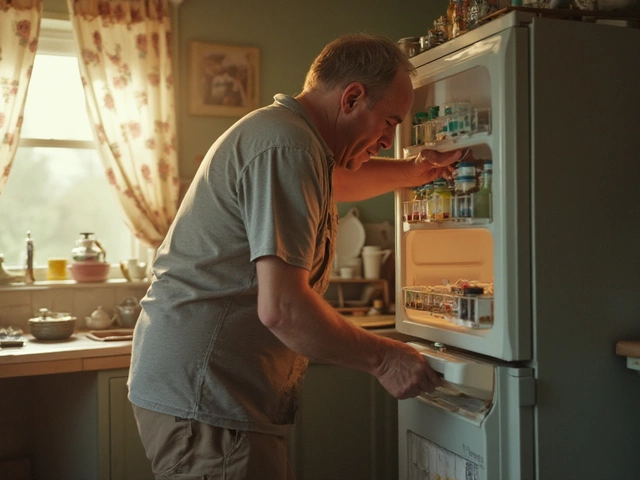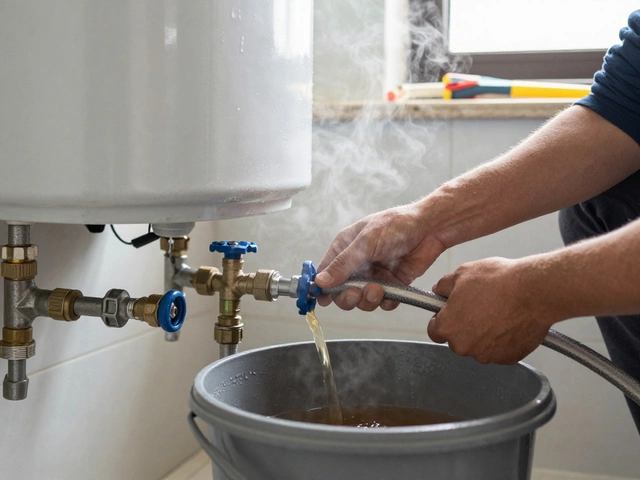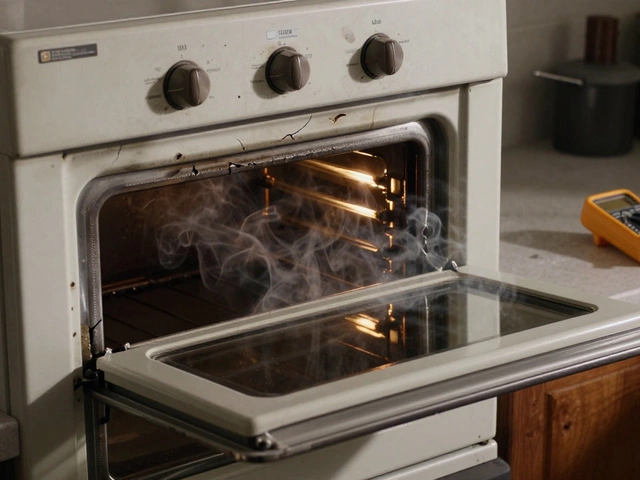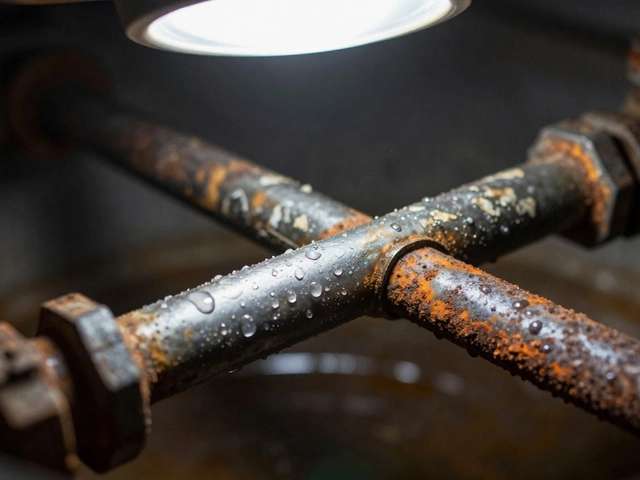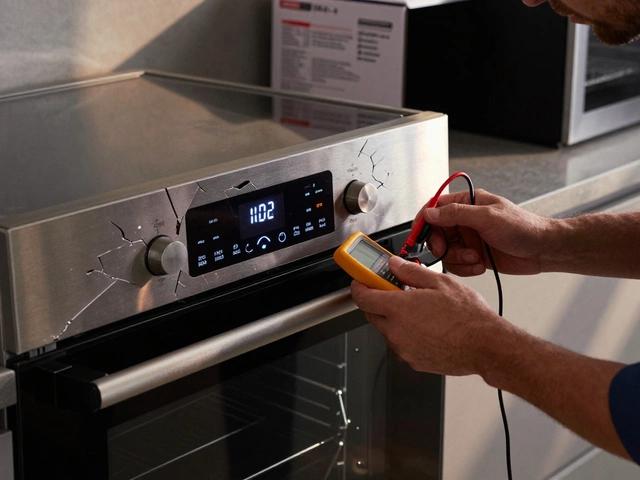In a world where appliances make or break our daily routines, a malfunctioning fridge can feel like a crisis. Yet, before you panic and dial for help, it's worth considering that many fridge problems can be fixed without professional intervention. Whether it's a cooling issue or a mysterious noise, understanding the basics of fridge repair can not only save you money but also give you the satisfaction of solving a problem with your hands.
Let’s embark on a journey through the ins and outs of fridge repair. We'll explore common issues you might face, the tools you'll need, and when it might be time to bring in an expert. Think of it as a crash course in appliance troubleshooting, designed to empower even the least handy among us.
- Understanding the Common Issues
- Essential Tools for DIY Fridge Repair
- Step-by-Step Troubleshooting Guide
- Knowing When to Call a Professional
Understanding the Common Issues
When your refrigerator starts acting up, the first hurdle is figuring out what's wrong. Fridges tend to develop a myriad of issues that might not necessarily mean you need a brand-new appliance. Among the most common issues is the fridge not being cool enough. This problem can often be traced back to a faulty thermostat or blocked vents. It's crucial to check if your thermostat settings haven't been accidentally adjusted. If set too low, your food might start to spoil. Another aspect to examine is the airflow inside. Blocked vents can restrict airflow, affecting cooling efficiency. Also, ensure that coils under or behind the fridge are clean because dust and dirt can hinder heat dissipation, thus impacting cooling.
Another frequent conundrum is the fridge making strange noises. An unusual hum or clunk isn't just annoying; it could be a sign of something more severe. Most noises come from the compressor or the fan. Inspect fan blades to ensure they're not obstructed. Compressors, on the other hand, might need a professional's touch. However, checking that your fridge is level can also resolve many noise issues, believe it or not. An easy DIY fix could involve adjusting the leveling feet to ensure stability. Interestingly, according to a report from Consumer Reports, "60% of noise-related issues in fridges are attributed to improper leveling."
Water leakage is another problem that plagues many a refrigerator owner. Typically, this is due to a blocked defrost drain or a damaged water inlet valve. A clogged drain pan needs cleaning, a task easily accomplished with hot water and a little elbow grease. Moreover, checking the door seals is crucial. If seals are worn out, warm air might enter, causing condensation and leaks. Seals can usually be replaced without professional assistance. For those with ice dispensers, a malfunctioning water inlet valve can lead to puddles. These valves sometimes need replacing if cleaned without improving the situation.
Food spoilage or freezer burn could also suggest a deeper issue. Often, it's tied to fluctuating temperatures inside the fridge or freezer. Start by checking if your door closes shut properly. A door slightly ajar due to misaligned shelves or overloaded compartments can let cold air escape. Additionally, consider the impact of frequent door openings, especially in a busy household. The placement of the fridge also matters; avoid placing it near heat sources like ovens, as ambient temperatures can strain the compressor, leading to uneven cooling.
An interesting factor to consider is power cycling. You've probably noticed your refrigerator humming softly in cycles. If these cycles become erratic, it can indicate a compressor problem or an electrical issue within the circuitry. The appliance might be drawing more power than typical, signaling an internal issue like a failed condenser coil. This scenario often requires inspecting the fridge's rear compartment where most of these components reside. However, intervention should only be attempted by those comfortable with appliance innards or better left to experts.

Essential Tools for DIY Fridge Repair
Embarking on a DIY fridge fix requires gathering a few important tools that cover all possibilities. First and foremost, a set of screwdrivers, both flathead and Phillips, is non-negotiable. Fridge designs vary, and having the right type of screwdriver at hand will allow you to remove panels and access the innards of your refrigerator with ease. Imagine trying to loosen a bolt with the wrong tool; it's an exercise in futility. This simple tool is the cornerstone of any home toolkit, bridging the gap between a minor repair and a major project disruption.
Next on the list is a multimeter. This nifty device is crucial for checking electrical components and ensuring your fridge's parts are receiving power correctly. As appliances age, electrical issues can crop up unexpectedly, causing havoc. A multimeter can determine if a problem lies in a faulty wire or a failing component. As an enthusiast once said,
"A multimeter is the detective of the electrical world, uncovering the hidden clues that elude the naked eye."With this tool, the mystery of a malfunctioning fridge starts to unravel.
Don’t underestimate the importance of having a nut driver set. Many fridge components are fastened with nuts and bolts that differ in size and type. A nut driver set, with varied socket sizes, empowers you to tackle the task efficiently. You’ll often find that tight spaces require precision tools, and this set is your perfect partner in crime when securing or loosening those tricky connections tucked behind panels. Consider it akin to having the right key for a lock, essential for completing your repair journey.
Another unsung hero in the toolbox is the flashlight. While kitchen lighting can be effective, peering into your fridge’s dark corners needs a dedicated beam. A well-aimed flashlight helps identify leakages, frost buildup, or misplaced wiring. It illuminates the unseen and brings clarity to your diagnostic efforts, making it indispensable during any fridge repair attempt. A simple light can transform confusion into comprehension, lighting up both your workspace and your understanding of the issue.
Finally, stock up on replacement parts like seals and fuses, which often fail or wear out over time. These components are among the most common culprits when troubleshooting fridge issues. Ordering parts specific to your fridge’s make and model forehand can save time and reduce frustration during repair. Having them ready ensures you don’t lose momentum during your DIY session. Unlike other life’s problems, with preparedness in parts, your fridge fix might just have a pleasant ending.

Step-by-Step Troubleshooting Guide
When your refrigerator begins to falter, it's vital to approach the problem calmly and methodically. First, let's consider the myriad of reasons your fridge might not be performing as it should. Perhaps it's not cooling properly, there's a buildup of frost, or even odd noises that pierce the daily silence. Each symptom can provide clues toward the underlying issue. Start by taking stock of what seems off with your unit; this observational step is crucial. Are the items in the fridge not as cold as they should be? Is there a water puddle developing beneath it? Note these signs down, and keep in mind that sometimes a solution is simpler than it looks.
Once you have observed the symptoms, the next step is to ensure your fridge is receiving power correctly. Check the outlet and power cord for any signs of damage or wear. Frequently, what seems like a complex issue may merely be a disrupted power source. After verifying the power status, let’s examine the temperature controls. It’s not uncommon for settings to get altered unintentionally — a quick check might reveal that it's set too high or low without your knowledge. If adjusting these settings does not yield results over a few hours, it might be time to consider deeper issues within the cooling system.
"A little knowledge that acts is worth infinitely more than much knowledge that is idle." — Khalil Gibran
Should the cooling remain inadequate after tweaking the settings, inspect the condenser coils. These are often located at the back or across the bottom of the refrigerator, gathering dust over time. This accumulation can severely impede airflow, causing inefficiencies. Unplug the unit for safety, then clean them using a coil brush or vacuum. This maintenance step is often overlooked but can have a substantial impact on the performance of your fridge. In some cases, the coils might be damaged, at which point seeking a replacement is wise.
If none of the previous steps alleviates the issues, delve into examining the evaporator fan. It's crucial for pushing cold air throughout the fridge, and if it’s not working, cooling everywhere else will be suboptimal. Access this by unscrewing the back panel inside your freezer compartment, listening for any unusual sounds, or watching for signs of blocked or slowing blades. Remember, proper airflow is the backbone of an efficient refrigerator system. If doubt persists regarding the fan’s functionality, replacing it might be less costly in the long run than constant repairs.
Let’s not overlook leaks and puddles—these often stem from blocked defrost drains. If water accumulates, it might lead to malfunctioning or even damage other components. Cleaning these drains with warm water and mild soap should help clear blockages. If issues with leaks persist, continue checking associated components, such as the water filter or ice maker, for faults. Each part interplays, creating a delicate system best known to those with a penchant for puzzles, or in this case, fridge repairs.
Finally, if your fridge still doesn’t work beyond your DIY expertise, it might be time to consult a professional. While some problems are manageable, advanced technical issues may require specialized knowledge. Understanding when to seek help can save both time and money by preventing costly damages. Remember, the key to successful fridge repair often lies in patience and a systematic approach. Embrace the challenge, and you'll find that fixing a DIY fridge fix yourself can be a truly rewarding endeavor.

Knowing When to Call a Professional
Sometimes, despite your best efforts and commitment to fixing your fridge repair needs on your own, there comes a point where calling in a pro is the wisest option. The first red flag is when you notice a persistent irregularity that doesn't seem to improve after your DIY attempts. This might include a continuous leak, a motor that's running excessively hot, or inconsistent cooling. When your troubleshooting isn't aligning with positive results, it’s an indication that something complex could be lurking beneath the surface, something that requires the know-how and touch of a seasoned technician.
Another crucial moment is when your fridge's warranty comes into play. Many individuals jump into a DIY fridge fix without realizing that tinkering with certain components can void their appliance's warranty. If your refrigerator is still under warranty, it's a good idea to seek professional intervention to avoid unnecessary costs down the line. Moreover, professionals are usually updated on the latest recalls or safety alerts pertaining to specific fridge models, giving them an edge in ensuring all aspects are considered during repair.
"Safety and reliability should never be compromised," says an expert from Appliance Repair Services. "Knowing when to call us can save more than just time; it can save your appliance's lifespan."
One sure sign that professional help is required is when you’re dealing with refrigerant issues. Refrigerants are complex and require a meticulous approach, and dealing with them without proper training can be hazardous. A certified technician not only assesses the level of refrigerant but also checks for any potential leaks. They have the tools and certifications needed to handle refrigerants safely, adhering to environmental guidelines that laypersons might overlook.
The Cost-Effectiveness of Professional Help
While the initial idea of saving money through a DIY fridge fix might be tempting, the cost factor is another point to contemplate. In some cases, DIY repairs can lead to further damages if not handled correctly, resulting in more expensive repairs than anticipated. Professionals usually offer diagnostic visits that pinpoint the exact issue and propose a solution before work begins. This kind of service often prevents runaway costs from piling up as a result of trial and error. Additionally, they bring in experience alongside their expertise, spotting issues that might not be on your radar.
Finally, consider your own comfort level and technical ability. Not everyone is cut out for diving into appliance interiors, with manuals sprawled across the living room floor. Feeling unsure is a tremendous sign that a professional’s skilled hand is needed. They can provide peace of mind, ensuring the appliance is returned to its optimal state with efficiency and safety in mind. Sometimes, knowing when not to act is the key to maintaining a harmonious and seamless home environment.



